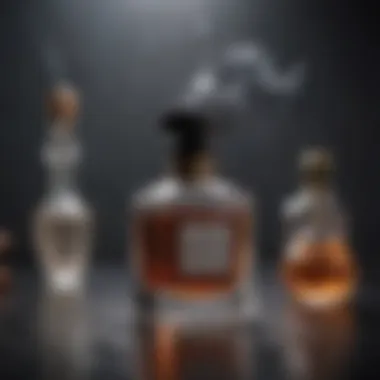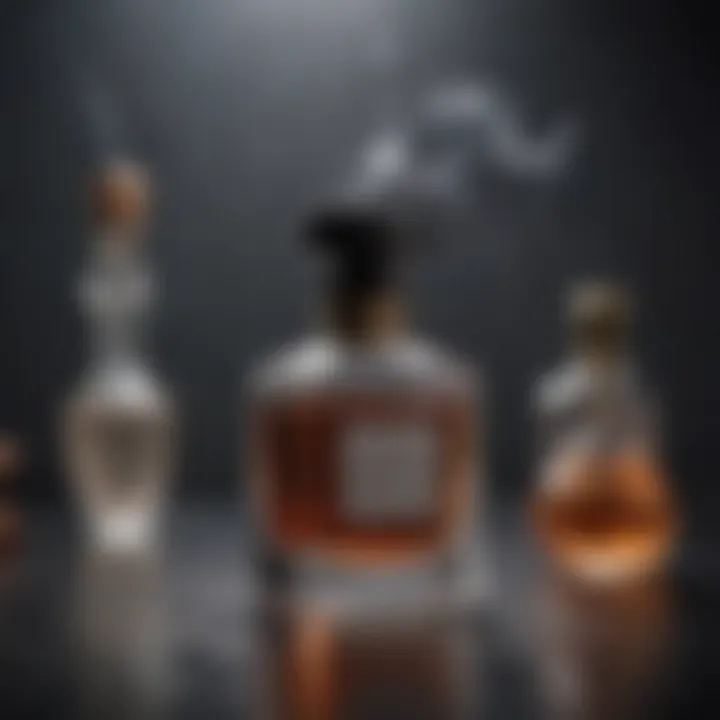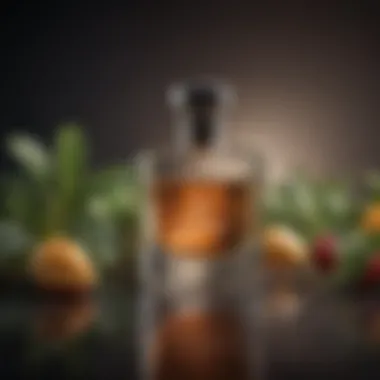The Science and Art of Perfume: An In-Depth Exploration


Intro
Perfume serves as a captivating intersection of science and art. Each scent is a composition of various elements that evoke unique emotions and memories. In understanding perfume, we can appreciate its historical significance and cultural impact. This article will explore what constitutes a fragrance, how it affects our perceptions, and the creative processes behind its creation.
Throughout history, perfumes have played a pivotal role in various cultures. From ancient Egyptians who used resins and oils for religious rituals to modern-day fragrance houses that produce complex scent profiles, the evolution of perfume reflects human creativity and scientific advances.
Next, we will analyze key concepts related to perfume, dissecting the terminology and theories that define this intricate field.
Prelude to Perfume
Perfume serves as much more than a mere accessory; it encapsulates history, culture, and a myriad of sentiments. By understanding this complex blend of science and art, readers can cultivate a deeper appreciation for fragrances and their implications in various aspects of life. The exploration of perfume broadens our perspectives on sensory experiences and their connections to identity, memory, and emotion.
In this article, we will discuss the multifaceted nature of perfumes, from their definitions to their historical contexts. Knowledge of perfumes is not just important for connoisseurs but also for anyone who encounters this alluring element. The insights gained will help both laypeople and professionals enhance their choices in scent selection and better understand the intricate world of fragrances.
Defining Perfume
To define perfume, we must consider its fundamental components: fragrance oils, alcohol, and sometimes water. Perfume creates an olfactory experience designed to leave a lasting impression. Generally, perfumes vary in concentration and composition, which affect their intensity and longevity.
Perfumes can be categorized into distinct classifications based on their scents, such as floral, citrus, woody, and oriental, among others. Each category evokes unique emotional and psychological responses.
Additionally, understanding terms like "notes" and "sillage" can enrich our comprehension. "Top notes" are the first scents perceived, followed by the "heart notes," which emerge after the top notes fade. Finally, the "base notes" form the lasting scent that lingers. Sillage, on the other hand, refers to the trail of scent left behind, influencing how a fragrance is perceived by others.
A Brief History of Perfume
Perfume’s history dates back thousands of years, transcending many cultures. The art of scent began in ancient civilizations like Mesopotamia, where people used natural resins and infusions for rituals and personal adornment. Egyptians expanded upon this tradition by integrating perfume into burial practices and daily life, creating significant advancements in fragrance production.
As trade expanded, the knowledge and art of perfumery traveled through Europe and Asia. The Romans utilized scented oils for bathing, while the Middle Ages saw the development of distillation methods. By the Renaissance, the popularity of perfume surged in Europe, particularly in France, becoming a symbol of luxury and sophistication.
This historical background highlights the evolving perceptions and uses of fragrance, influencing contemporary practices in the scent industry.
The Chemistry of Scent
Understanding the chemistry of scent is fundamental in the study of perfume. Scent is not only a subjective experience but also a complex scientific phenomenon. The way we perceive fragrance involves intricate interactions between chemical compounds and our sensory systems. Exploring this topic reveals how molecules combine to create distinct scents, the implications for fragrance formulation, and how this knowledge can enhance our understanding of human emotions and preferences.
A detailed comprehension of scent chemistry allows perfumers to craft compositions that evoke specific emotional responses. It also helps in ensuring product safety and compliance with various regulations. When analyzing the importance of scent chemistry, consider the technological advancements that have allowed for a deeper exploration of olfactory science. Through these insights, the perfume industry can innovate while respecting tradition.
Understanding Fragrance Molecules
Fragrance molecules are the building blocks of any perfume. These molecules can be classified into several categories: top notes, middle notes, and base notes.
- Top Notes: These are the initial scents perceived right after application. They tend to be light and evaporate quickly. Common examples include citrus and herbal notes.
- Middle Notes: Often termed heart notes, these are detected after the top notes diminish. They form the core of the fragrance and often include floral and fruity scents.
- Base Notes: These are the scents that linger after the perfume has matured. They provide depth and richness, with common examples being vanilla, musk, or amber.
The combination of these notes creates a harmonious fragrance that develops over time. Different molecules have varying volatilities and solubilities, which influence how a fragrance is experienced. This is integral in ensuring that a scent transitions smoothly from the initial application to its final dry down.
The Role of Olfactory Receptors
Olfactory receptors are proteins located in the nasal cavity. They play a crucial role in detecting scents. Humans possess approximately 400 different types of olfactory receptors. Each receptor responds to specific scent molecules, sending signals to the brain when these molecules bind.


This process is intricate:
- Recognition: A scent molecule attaches to an olfactory receptor.
- Signal Transduction: The receptor then activates, triggering a cascade of biochemical events.
- Perception: The information travels through the olfactory bulb to the brain, where it is processed and recognized.
The understanding of olfactory receptors is vital for perfumers. It dictates how certain scents can be blended or how they might appeal to various demographics. Furthermore, research into genetic variations in olfactory receptors can explain why preferences differ among individuals. This knowledge can guide fragrance development, ensuring that the resulting perfumes resonate with intended audiences.
Cultural Significance of Perfume
Perfume holds a prominent place in human culture, transcending mere personal allure to encompass various aspects of life, ritual, and tradition. Throughout history, scents have been utilized not only for their aromatic qualities but also for their psychological and social implications. Understanding the cultural significance of perfume allows one to appreciate its profound influence on identity and expression. From ancient practices to contemporary interpretations, fragrance reveals much about societal values, relationships, and self-perception.
Perfume in Ancient Civilizations
In ancient civilizations, such as Egypt and Mesopotamia, perfume was considered a divine gift. The Egyptians used scents in their religious rituals. They offered incense to deities and believed that fragrances were the essence of the gods. The use of aromatic oils in mummification also emphasized the significance of scent in their beliefs about the afterlife. In Mesopotamia, perfume-making was a fine art, with artisans meticulously blending ingredients to create complex olfactory profiles. Historical records show that the ancient Sumerians had an early form of perfume industry, revealing the economic and social importance of fragrance.
Notably, in Greece and Rome, fragrance became a marker of status. Wealthy individuals adorned themselves with scents that reflected their affluence. The Greeks associated certain scents with various cultural practices, including theater and athletics. They believed that perfumes enhanced physical appeal and social standing. Likewise, in Roman society, scented oils and perfumes were vital during public events and banquets, fostering social connections. Thus, the historical context shows how perfume was not just an accessory but an integral part of cultural identity.
Modern Interpretations of Scent
In contemporary society, perfume continues to shape personal and cultural narratives. It serves not only as a form of self-expression but also as a catalyst for emotional connections. Modern perfumery draws from a deep well of tradition while embracing innovation. The rise of niche perfumers demonstrates a shift toward individuality and customization in fragrance, allowing consumers to curate their olfactory identities.
Modern marketing strategies often highlight the symbolic nature of scents, linking them to specific moods or moments. Advertisements frequently depict scents as lifestyle enhancers, promoting experiences rather than just products. The widespread availability of fragrances reflective of various cultural influences caters to a diverse audience.
"Perfume, once viewed as a luxury, has evolved into an accessory that speaks to personal identity and social expression."
Furthermore, there has been a notable focus on sustainability and ethical sourcing in the perfume industry. Consumers increasingly seek products that align with their values, showing greater awareness of the ecological impact of fragrance production. This highlights an essential cultural shift towards responsibility and mindfulness, where fragrance choices reflect broader societal issues.
In sum, the cultural significance of perfume spans centuries, showcasing its role in shaping identities and relationships. From ancient rituals to modern interpretations, scent remains a vital facet of human experience. By examining the history and evolution of fragrance, one gains insight into the values and connections that define our lives.
The Process of Creating Perfume
Creating perfume is both an art and a science that involves a multitude of intricate steps. The process is vital because it transforms raw materials into something that carries emotional and sensory significance. Understanding how perfumes are crafted allows individuals to appreciate the skill, creativity, and effort invested into each unique scent. This section will cover the three essential stages in perfume production: sourcing raw materials, crafting a fragrance, and the role of perfumers in this field.
Sourcing Raw Materials
Raw materials are the backbone of any perfume. The quality and variety of these ingredients greatly influence the final product. Perfume ingredients can be classified into two main categories: natural and synthetic. Natural materials include essential oils derived from flowers, fruits, spices, and woods. In contrast, synthetic ingredients are created in laboratories to replicate complex scents. This brings several benefits:
- Consistency: Synthetic materials provide reliable quality and scent profiles.
- Sustainability: Some natural resources are limited. Synthetic components can reduce the strain on these resources.
- Diversity: Many scents can only be created synthetically, allowing greater creativity in perfume design.
However, ethical considerations in sourcing are increasingly crucial. Sustainable and responsible sourcing practices must be prioritized to protect biodiversity and support local communities. This shift is becoming essential in today's perfume industry as consumers grow more conscious of the origins of what they wear.
Crafting a Fragrance
Crafting a fragrance is a complex process that typically begins with concept development. This is where the perfumer determines the theme and direction of the perfume. Based on this vision, the perfumer selects various raw materials that fit the desired scent profile.
The mixing of these scents is often done in layers to develop depth. This layering allows for the formation of notes:
- Top notes: The initial scents sensed upon application, light and fleeting, often citrusy or herbal.
- Middle notes: These develop after the top notes fade, providing the main characteristic of the fragrance, often floral or fruity.
- Base notes: The foundation that lasts the longest, providing depth and richness, often woody or musky.
The blending process requires expertise and precision. Perfumers must consider how each note evolves over time and interacts with others. This is where artistry meets science, as the correct balance can evoke emotions, memories, and feelings.


The Role of Perfumers
Perfumers, often referred to as ‘noses’, play a pivotal role in the fragrance industry. Their expertise lies in their ability to identify, blend, and enhance scents. A successful perfumer not only possesses a refined sense of smell but also an understanding of chemistry, allowing them to predict how different ingredients react together.
Education and training programs are rigorous. Many perfumers start as apprentices, working under the guidance of experienced mentors. Their journey involves:
- Evaluating raw materials: Understanding the scent profile and potential impact on the final product.
- Testing and adjusting formulations: Continuous experimentation is essential to refine the scent.
- Staying updated on trends: Knowledge of current consumer preferences and industry trends helps guide their creative process.
Psychology of Perfume Selection
Perfume selection is not merely about choosing a fragrance; it is deeply intertwined with psychological principles. Understanding how scent influences emotions and behaviors is crucial for marketers, perfumers, and consumers alike. A scent can evoke specific moods or memories, making the psychology behind perfume selection a vital area of exploration. The dual aspects of emotional response and social context play significant roles in how individuals choose their fragrances.
The impact of scent on emotions is notable. For instance, certain smells can trigger happiness or nostalgia, while others may bring about sadness or anxiety. Perfumes often tell stories or represent aspects of our identity. Choosing a fragrance may be an expression of personality, mood, or even aspirations. Some people might even select a scent to lead others to perceive them in a certain light. Therefore, understanding these psychological factors can enhance one’s approach to both marketing and personal selection of fragrances.
How Scents Influence Emotions
The ability of scents to influence emotions stems from the direct path from the olfactory system to the brain's limbic system. This part of the brain is responsible for emotion and memory. Therefore, it is no surprise that inhaling a particular fragrance could lead to emotional reactions. Scents can evoke vivid memories or feelings, making them powerful tools for emotional manipulation.
- Essential oils like lavender are often used for relaxation, while citrus scents may energize individuals.
- The fragrance of vanilla can induce feelings of comfort and hearth.
- Floral scents tend to be associated with romance or celebrations.
Brands utilize these emotional triggers strategically when marketing their products. Associates might suggest scents that align with the mood customers want to cultivate or project, thereby enhancing the shopping experience and facilitating sales.
"Our sense of smell can inspire feelings and memories. It becomes an emotional language that communicates without words."
Choosing the Right Perfume
Selecting the appropriate perfume requires consideration of several factors. Here are important elements to keep in mind:
- Personal Preference: Everyone has unique taste in fragrance. One must consider personal likes and dislikes when selecting a scent.
- Occasion: The context in which the perfume will be worn matters. An office scent should be subtle, whereas perfumes for social gatherings can be bolder.
- Skin Chemistry: Scents can change based on individual skin chemistry. It is advisable to test perfumes on oneself rather than solely relying on how they smell in the bottle.
- Seasons: Scents can also be seasonal. Lighter scents are often preferred in summer, while richer fragrances are associated with fall or winter.
By thoughtfully considering these factors, individuals can ensure that their fragrance aligns well with their lifestyle and the emotions they wish to convey. Choosing a perfume becomes more than just picking a scent; it transforms into a personalized expression of self.
Trends in the Perfume Industry
The perfume industry, like many sectors, is continuously evolving. This dynamic environment demands attention to emerging trends that influence consumer preferences and production methods. Identifying these trends is crucial for understanding not just the market, but also cultural shifts and technological advancements.
Natural vs. Synthetic Ingredients
In recent years, there has been an increasing conversation surrounding natural versus synthetic ingredients in perfumes.
- Natural Ingredients: These are derived from plants, flowers, and other naturally occurring substances. Many consumers are moving toward natural products, seeking transparency and environmental sustainability in their choices. Natural ingredients are often perceived as healthier, but they also come with challenges such as higher costs and limited availability.
- Synthetic Ingredients: These are created in laboratories and can replicate scents from nature or produce entirely new fragrances. Synthetic components allow for broader creativity and lower manufacturing costs. However, some consumers have concerns about potential skin sensitivities and the environmental implications of synthetic production processes.
The ongoing debate between natural and synthetic ingredients emphasizes a fundamental shift in consumer attitudes. The rise of eco-consciousness is pushing brands to reassess their formulas. Companies need to strike a balance between appealing to ethical consumers while ensuring the quality and safety of their products.
Fragrance Personalization
Fragrance personalization is another significant trend. Advances in technology are allowing brands to offer tailored scent experiences that cater to individual preferences. This trend is driven by consumer desires for unique products that express their identities.
- Customizable Perfumes: Many brands now offer options that let customers mix and match different notes to create a personalized blend. This approach fosters a deeper connection between the consumer and the product.
- Data-Driven Recommendations: Using customer data and AI, retailers can suggest fragrances aligned with personal tastes. This use of technology enhances the shopping experience, making it more engaging and efficient.


The movement toward fragrance personalization speaks to a broader desire for individuality and relevance in consumer products. Brands that can adapt to this trend will likely gain a competitive edge.
"The essence of personalization is not just about creating unique products; it is about creating memorable experiences that resonate with each individual."
The trends in the perfume industry highlight the need for constant adaptation. Understanding the nuances of natural versus synthetic, as well as the importance of personalization, is vital for stakeholders in this sector.
Sustainability and Ethical Considerations
The perfume industry is intricately linked to various environmental and ethical concerns. As consumers are increasingly aware of the impact their choices have on the planet, brands are being pressed to adopt sustainable and ethical practices. This topic is crucial, as it highlights the need for responsibility in sourcing ingredients and the effects of fragrance production on nature. Sustainability is not only about conserving resources; it's also about ensuring that these practices benefit local communities and preserve biodiversity.
Sustainable Sourcing Practices
Sustainable sourcing in the fragrance industry involves obtaining raw materials in ways that are environmentally friendly and socially responsible. This means selecting ingredients from suppliers that prioritize ecological practices. For instance, essential oils derived from plants can be sourced in methods that do not deplete local resources. Overharvesting of ingredients such as rose or sandalwood leads to their endangerment, creating a need for farmers to practice regenerative harvesting methods.
Benefits of sustainable sourcing include:
- Environmental Protection: By supporting practices that protect ecosystems, brands can actively contribute to biodiversity preservation.
- Community Support: Often, sustainable sourcing empowers local communities by providing fair wages and supporting local economies.
- Consumer Trust: Many consumers seek brands that align with their values, enhancing customer loyalty through ethical practices.
It is essential for companies to document their sources and practices, ensuring transparency in their supply chains. This approach not only increases accountability but also fosters trust and confidence among consumers regarding product integrity.
Impact of the Fragrance Industry on the Environment
The fragrance industry has a complex impact on the environment. Manufacturing processes can take a significant toll on natural resources. The extraction of raw materials often requires immense amounts of water and energy, contributing to pollution and habitat destruction.
"The fragrance sector must reconsider its practices to mitigate its environmental footprint."
Moreover, synthetic ingredients, while efficient, can pose their own risks. Some synthetic compounds are derived from petroleum, presenting a cyclical issue of fossil fuel dependency and environmental degradation. Additionally, the disposal of packaging materials contributes to waste, as many perfume bottles are not recycled easily due to their glass composition and decorative elements.
Key considerations include:
- Lifecycle Assessment: Analyzing the environmental impact of perfume from ingredient sourcing to production and disposal.
- Biodegradable Packaging: Innovating packaging materials that lessen environmental burden on landfills.
- Education on Responsible Use: Encouraging consumers to understand the importance of responsible fragrance use and disposal practices.
Addressing sustainability and ethical considerations in the fragrance industry is not merely a trend; it is an imperative. As awareness grows, there is a collective responsibility within the industry to ensure that future generations can enjoy the artistry of perfume without the costs to our planet.
Ultimately, integrating these values into the business model will enhance innovation and lead to a more sustainable future for the perfume industry.
End: The Future of Perfume
As the perfume industry continues to evolve, understanding its future becomes increasingly essential. Conclusion: The Future of Perfume encapsulates significant advances in technology, shifts in consumer preferences, and broader environmental considerations that will shape how fragrances are created and experienced.
Emerging Technologies in Fragrance Creation
New technologies are revolutionizing how fragrances are developed. For instance, the use of artificial intelligence and machine learning allows perfumers to analyze vast datasets to predict fragrance trends. This helps them craft scents that resonate with consumers on a deeper level. Companies like Givaudan and Firmenich are at the forefront of this innovation, using predictive analytics to understand market demands better.
Additionally, 3D printing technology has started to influence the packaging of perfumes. This method allows for more intricate designs that can be customized for individual consumer preferences, thus enhancing the overall experience. Moreover, biotechnology is being explored to cultivate scent molecules in a more sustainable way. This not only addresses ingredient scarcity but also reduces the environmental impact associated with traditional scent extraction methods.
The future of perfume lies at the intersection of science, technology, and artistry.
The Ongoing Appeal of Perfume
Despite changes in trends and technology, the appeal of perfume endures. Many individuals use fragrances as a form of identity or self-expression. The emotional connection tied to scents remains strong, with studies showing that certain fragrances can evoke memories and feelings, significantly influencing personal choices.
Furthermore, luxury brands are increasingly incorporating personalization in fragrance offerings. This trend caters to consumers seeking distinct, customized scents that reflect their individuality. The ongoing relevance of classic fragrances also illustrates how timeless scent can resonate across generations.
In summary, the future of perfume is marked by technological advances alongside an evolving appreciation for scent. As emerging trends reshape the industry, understanding these dynamics can provide insights into consumer behavior and preferences. This understanding is crucial for professionals in the field, ensuring that they stay relevant and connected to the desires of modern fragrance enthusiasts.



